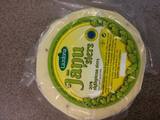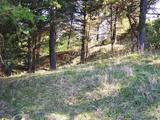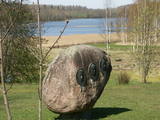| Nr | Nosaukums | Apraksts |
|---|---|---|
|
The distance from Riga to Tallinn is more than 300 km and it takes approx. 5 hours by bus. Therefore we suggest stopping on the way for a brief excursion to a herb farm and lunch in a country pub. This stopover is approx. 1.5 hours’ drive from Riga, just at that point when one needs to stretch one’s legs and enjoy a change of scene. The visit will give an insight in rural life and it may surprise visitors to learn how well Latvians understand nature, knowing and using herbs for food, health and beauty. After the excursion, the group will have lunch in a country pub serving meals made from locally grown ingredients. |
||
|
Līdz akmenim aizved (ir norādes) skaista taka, kas līkumo pa Rogāļu strauta izrauto gravu. Strauta kreisā krasta nogāzē, ~ 0,1 km pirms tā ietekas Daugavā, iegūlis 6,5 m garais, 4,6 m platais un līdz 3,7 m augstais Rogāļu akmens, kura tilpums ir novērtēts ap 40 m³. Blakus tam atrodas liela atlūza. |
||
|
Diplomēts mežsaimnieks Imants Urpens Alojas novada "Ošlejās" audzē šitaki sēnes. Šī ir arī mācību saimniecība, uz kuru brauc mācīties pārsvarā ārzemnieki. Saimniecība ir bioloģiski sertificēta. Pieņem ekskursijas un pasūtījumus sēņu audzēšanai un micēlija iegādei. |
||
|
Uzņēmumā ražo pienu, krējumu, biezpienu un biezpiena izstrādājumus, jogurtus, desertus. Produkcija tiek pagatavota no augstas kvalitātes izejvielām – piena, ko iepērk no vairāk nekā 100 zemnieku saimniecībām un 3 kooperatīvām sabiedrībām. Ražošanas gaitā tiek ievēroti un uzlaboti visi tehnoloģiskie procesi, lai produkts saglabātu savu vērtību un uzlabotos tā garša un uzturvērtība. Uzņem ekskursijas un organizē degustācijas. Viens no pieciem Latvijas uzņēmumiem, kas drīkst ražot ES garantēto tradicionālo īpatnību produktu - „Jāņu sieru”. Produktiem ir kvalitātes zīme „Zaļā karotīte”. |
||
|
Vienīgā šāda veida skatu platforma - celta ziemeļos no Pāvilostas – starp jūras krastu un Latvijas lielāko pelēko kāpu. No otrā stāva labi pārskatāmi pelēkās kāpas biotopi, jūras krasts, lielākais Baltijas jūras piekrastes akmens – Pāvilostas jūrakmens, Pāvilostas ziemeļdaļa, bet vējainā laikā – kaitbordistu meistarstiķi.
|
||
|
Maršruts ar ļoti neparastiem skatiem! Seda ir vienīgā Latvijas pilsēta, kurai saglabājies pagājušā gadsimta vidus padomju laika plānojums ar centrālo laukumu un tam starveidā pieguļošām ielām. Sava veida eksotika ir dzīvojamo un sabiedrisko māju arhitektūras stils. Sedas purvs, kurā kūdra jau ir iegūta no Latvijas pirmās brīvvalsts laika, ir viena no lielākajām šāda veida industriālām - dabas teritorijām Latvijā un Baltijas valstīs. Agrāk izstrādātie kūdras lauki ir daļēji applūduši un aizauguši ar niedrēm, veidojot izcilu vidi ligzdojošajiem ūdensputniem un migrējošiem putniem, kas Sedas purvu izmanto kā atpūtas vietu. Kūdras ieguve turpinās arī mūsdienās un varbūt paveiksies ieraudzīt „mazo kūdras vilcieniņu”. Maršruta informācija no Latvijas Lauku foruma |
||
|
Vieni no lielākajiem Latvijas kazkopības produkcijas ražotājiem. Audzē ~ 300 tīršķirnes kazas (Alpu, Anglo, Vācu baltā dižciltīgā) un mājas cūkas kuiļus (vaislai). Ekskursija un iesaistīšanās kazu ganīšanā. Sākot no marta - kazlēnu apskate. Vairāku siera šķirņu degustācija, slaukšanas (ap 17:00 dienā) demonstrēšana. Piedāvā arī gaļas konservu degustāciju un iegādi. Produktiem nepievieno konservantus! Jaunums: saldējums no kazas piena. |
||
|
Skaisto un mūsdienās atjaunoto zilā krāsojuma ēku Karaīmu ielas 5 malā sākotnēji (1810. g.) cēla Dominikāņu mūki. Kopš 1864. g. tajā 23 gadus saimniekoja policija, līdz 1887. g. te izvietoja pastu un telegrāfu. Šobrīd ēkā atrodas nacionālā parka administrācija. |
||
|
Saimniecībā gatavo kazas piena sieru un citus kazas piena produktus. Šeit audzē kazas, aitas, trušus un mājputnus. Produktus var iegādāties, iepriekš pasūtot, vasarā tiek rīkotas arī ekskursijas pa saimniecību. |
||
|
Skaistā, sakoptā un mākslinieciski iekārtotā viensēta atrodas Jaunpiebalgas pagastā. Viensēta iekļaujas apkārtējā ainavā, vecā kūts ir mūsdienīgi atjaunota un tās augšstāvā iekārtota saimnieces, kura ir tekstilmāksliniece, darbnīca un izstāžu zāle. Atjaunota arī veca guļbūve un no jauna uzbūvēta pirtiņa. Sētai cauri tek upīte, un teritorijā atrodas arī Tulejas pilskalns, kas ir valsts mēroga aizsargājamais dabas objekts. |
||
|
Atrodas Strīķupes labajā krastā pie Cēsu – Lenču ceļa. 45 m garā un līdz 5,5 m platā ala un tuvējais smilšakmens atsegums līdz šim bija ļoti cietis no apmeklētāju nekrietnas uzvedības, tādēļ nacionālā parka administrācija pirms dažiem gadiem ierobežoja apkārtējo teritoriju, ļaujot alu un atsegumu apskatīt tikai „no malas". Šis ir uzskatāms par pozitīvu nozīmīga ģeoloģiska dabas pieminekļa un aizsargājama biotopa aizsardzības piemēru. |
||
|
Micānu - Kirkas kalns. Mazā pils Priežukalnā (Kirkas kalnā) 1792. gadā
tika pārveidota par luterāņu baznīcu. Tādēļ šo kalnu arī šodien sauc
par Kirkas kalnu (tulkojumā no vācu valodas – Baznīcas kalns). Vecie
ļaudis ir stāstījuši, ka zem baznīcas esot izbūvēts liels pagrabs, kurā
glabājušās baznīcas un Manteifeļu dzimtas dārglietas, kā arī pagrabā
atrodas Manteifeļu dzimtas kapenes.
|
||
|
Saimniecībā tiek audzēti alpakas, lamas, kamieļi, ēzeļi, strausi, holandiešu āži, šinšilas un truši. Kopā ar saimniekiem dzīvniekus var pabarot, paglaudīt un kopā nofotografēties. Saimniecībā ir ierīkotas lapenes. Kafejnīcā var pacienāties ar kafiju un uzkodām. Tāpat var iegādāties suvenīrus un alpaku vilnas izstrādājumus. |
||
|
Vientuļš, mežu ieskauts un sens ceļš starp Košragu un
Dūmeli, ar ko saistīti daudzi interesanti fakti gan par Pitragupes dzirnavām,
kas ne reizi tā arī nav malušas (vēl manāmas uzbērumu paliekas), par kāda
avarējuša kuģa tvaika katlu, ko vietējais barons te izmantojis darvas tecināšanai,
gan kādreizējo zirgu ceļu, kas šķērsojis Bažu purvu, gan iespaidīgo Dūmeles
dižakmeni.
|
||
|
Kodas is a forward-thinking cider brand from Southern Estonia, known for its sustainable and precise approach to cider-making. They grow over 30 apple varieties organically, ensuring authentic flavors without artificial additives. Kodas emphasizes pure, undiluted apple juice in their ciders, collaborating with fermentation experts to refine unique production methods. Sustainability is central to their philosophy, with a zero-waste approach that transforms apple byproducts into spirits, purees, and more. Kodas rebranded in 2021, expanding its focus to include non-alcoholic beverages, spirits, and food products, all crafted with a balance of tradition and innovation. |
||
|
The main goal of the Vestiena protected landscape area is to protect the landscape values in the Vidzeme highlands. The protected area is in the middle of the Vidzeme highlands with the highest and most prominent relief, including Gaiziņkalns, the highest spot in the country. The many lakes found in the area - Viešūrs, Talejas, Kāls, Pulgosnis and others – not only add to the variety of the landscape, but also offer tourism and recreation options. The Vestiena protected landscape area encloses several other especially protected/Natura2000 sites – the Gaiziņkalna nature park, the island of the lake Kāla, the lake Ilziņa restricted natural area. Among the most interesting tourist attractions are the Vestiena estate, the Piekūnu wandering trails, the Gaiziņkalna nature trail. The area is rich in landscapes, however, there are no viewing spots or towers installed to observe the landscape. On the top of the Gaiziņkalns, the Latvia’s highest spot, there still stands the wreck of the former viewing tower.
|
||
|
The Baltic Coastal Hiking Route leads around the Pakri Peninsula, from whose rocky shores you will discover the most beautiful coastal landscapes in northwest Estonia. It goes through the centre of Paldiski and, after having reached the fortress bastions of Peter I, it turns towards the Pakri Lighthouse going across the upper part of the impressive Pakri Cliffs. Further on up to Kersalu, there are both ups in the shape of rocks and downs where the Baltic Coastal Hiking Route meanders along a sandy and rocky seacoast and a beautiful pine forest. |
||
|
Atpūtas vieta ģimenes īpašumā Vārvē, kurā tiek piedāvāti pirts rituāli. Tāpat ir iespēja pārnakšņot namiņā un atpūsties pie dabas un Ventas upes. |
||
|
The first Catholic church in Ludza was built in 1687 and burned down. A new wooden Baroque church was built in 1738, and because of its colourful interior it became known as the loveliest wooden house of worship in Latvia. The church burned down during a great conflagration in 1938. Work on the church that is there began in 1939, but it was only completed in the early 1990s. |
||
|
The wooden tower was built and stands 28 metres high. It is at the top of the highest hillock of the Northern Courlandian Highlands – Kamparkalns Hill (175 metres above sea level). The tower offers one of the loveliest views in the region of the hillocks of Talsi. On a clear day, you can see all the way to the Bay of Rīga and Talsi. |
||

























